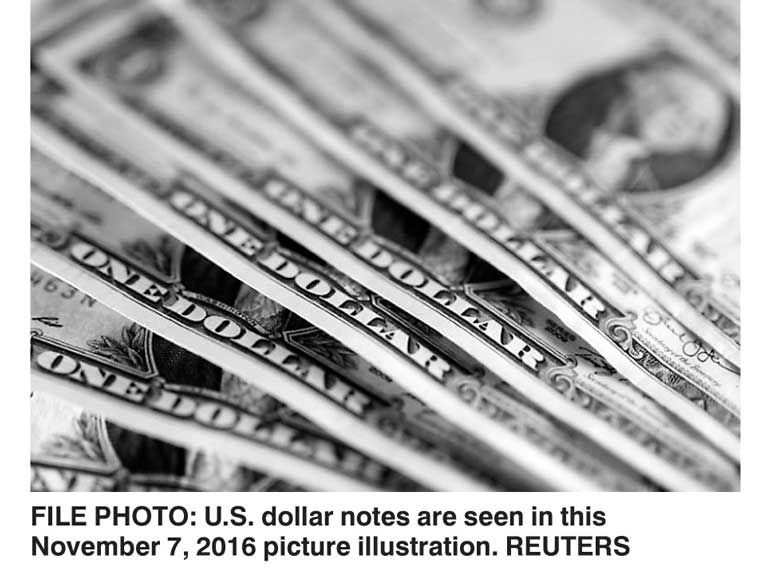Thursday Mar 06, 2025
Thursday Mar 06, 2025
Saturday, 30 September 2017 00:01 - - {{hitsCtrl.values.hits}}
 SYDNEY (Reuters): Asian shares regained some poise on Friday after a tough week in which the gathering risk of a US rate rise lifted Treasury yields toward nine-year highs and left the dollar on track for its best week so far this year.
SYDNEY (Reuters): Asian shares regained some poise on Friday after a tough week in which the gathering risk of a US rate rise lifted Treasury yields toward nine-year highs and left the dollar on track for its best week so far this year.
European markets have fared much better with Eurostoxx 50 futures at a three-month top in early trade, while the DAX and FTSE both added 0.2%.
E-Mini futures for the S&P 500 were steady near all-time peaks.
MSCI’s broadest index of Asia-Pacific shares outside Japan bounced 0.4%, but was still down 1.7% for the week so far. For the quarter, it looked set to gain 4.7%.
Japan’s Nikkei was a fraction lower, though South Korea managed to rebound 0.8%. Shanghai shares firmed 0.2% but were flat on the week.
Many Asian markets have been cold-shouldered this week as investors priced in a greater probability of a rate hike from the Federal Reserve in December.
Fed funds futures now imply around a 73% chance of a move at the Dec. 12-13 policy meeting, sharply higher than just a few weeks ago.
As a result, yields on two-year Treasuries reached a near nine-year top before settling at 1.46% on Friday. They had been as low as 1.254% early in September.
Adding to the upward pressure was President Donald Trump’s proposals for steep tax cuts which, if passed, could benefit US corporations’ profit margins.
The plan, however, lacked any detail on how it might be paid for and faces much opposition in Congress.
“As tax negotiations intensify, significant procedural, fiscal and political constraints are likely to become apparent,” cautioned Richard Franulovich, an analyst at Westpac, while noting the economic benefits of the plan were also in doubt.
“The size of the tax cut is simply too large to be realistic and repealing deductions will prove politically difficult.”
Still, a tax cut that made US equities more attractive while lifting the dollar and Treasury yields would likely prove negative for emerging markets, particularly those that relied heavily on foreign investment. The risk alone was enough to rattle share, bond and currency markets in Asia on Thursday, and they will remain vulnerable to headlines on the tax package as it moves through Congress.
Dollar reprieve
The jump in Treasury yields proved a much-needed tonic for the US dollar.
Against a basket of currencies the dollar was up 0.18% at 93.250, while gains for the week of 1.17% were the largest since December.
The euro hovered at $1.1776, having bounced from a six-week trough of $1.1715, but was still down 1.5% for the week so far. If it remains there, that would be the largest weekly loss since November 2016.
The dollar was also on track for its third week of gains on the Japanese yen at 112.66, just off a peak of 113.26.
On Wall Street, the Dow had ended Thursday with a minor gain of 0.18%, while the S&P 500 added 0.12% and the Nasdaq was flat.
All three were at or near record highs, stirring concerns about rich valuations.
The forward price-to-earnings ratio (P/E) on the S&P stood at 17.9 compared with its long-term average of 15.1, while the forward P/E on the Russell is 26.3 against an average of 21.3.
Important data on inflation from the European Union and the United States are due later in the session, along with economic growth figures in Canada.
Early readings on Chinese manufacturing are out on Saturday ahead of a week-long holiday in the Asian giant.
The EU also faces more political uncertainty on Sunday when Catalan separatists are set to defy Spanish efforts to block an independence referendum.
In commodity markets, oil prices were near to chalking up another weekly gain as investors wagered that efforts to cut a global glut are working and the demand outlook is improving.
Brent was 7 cents higher at $57.48 a barrel, heading for a fifth weekly climb and a 10-percent gain for September. US crude eased 9 cents to $51.48.
Discover Kapruka, the leading online shopping platform in Sri Lanka, where you can conveniently send Gifts and Flowers to your loved ones for any event including Valentine ’s Day. Explore a wide range of popular Shopping Categories on Kapruka, including Toys, Groceries, Electronics, Birthday Cakes, Fruits, Chocolates, Flower Bouquets, Clothing, Watches, Lingerie, Gift Sets and Jewellery. Also if you’re interested in selling with Kapruka, Partner Central by Kapruka is the best solution to start with. Moreover, through Kapruka Global Shop, you can also enjoy the convenience of purchasing products from renowned platforms like Amazon and eBay and have them delivered to Sri Lanka.
Discover Kapruka, the leading online shopping platform in Sri Lanka, where you can conveniently send Gifts and Flowers to your loved ones for any event including Valentine ’s Day. Explore a wide range of popular Shopping Categories on Kapruka, including Toys, Groceries, Electronics, Birthday Cakes, Fruits, Chocolates, Flower Bouquets, Clothing, Watches, Lingerie, Gift Sets and Jewellery. Also if you’re interested in selling with Kapruka, Partner Central by Kapruka is the best solution to start with. Moreover, through Kapruka Global Shop, you can also enjoy the convenience of purchasing products from renowned platforms like Amazon and eBay and have them delivered to Sri Lanka.